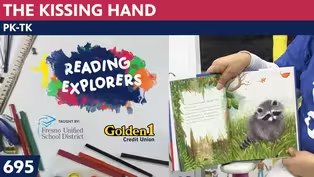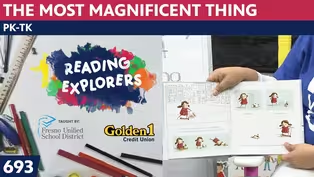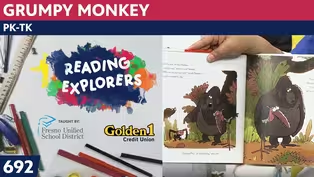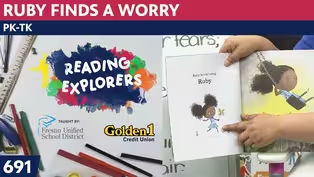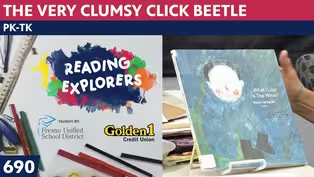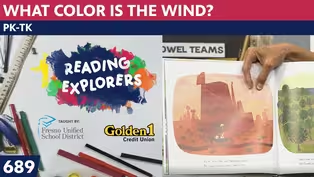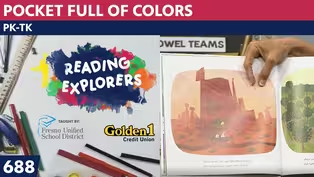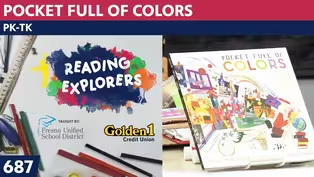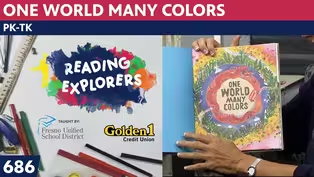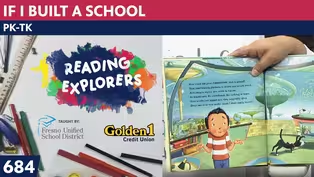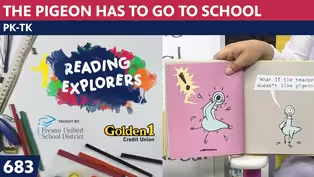
TK-366: Monet Water Lilies Study
Season 3 Episode 367 | 14m 7sVideo has Closed Captions
Join Mrs. Readwright at Camp Discovery!
Join me today as we begin a Monet Water Lilies study. Each day we will introduce Monet masterpieces that show his interest in the pond on his property. We will learn to prepare painted paper we will use during the week. If you would like to design paper that we will use when creating water lilies in the style of Monet, bring white, light blue, dark blue and green and pink paper, the same color
Problems playing video? | Closed Captioning Feedback
Problems playing video? | Closed Captioning Feedback
Reading Explorers is a local public television program presented by Valley PBS

TK-366: Monet Water Lilies Study
Season 3 Episode 367 | 14m 7sVideo has Closed Captions
Join me today as we begin a Monet Water Lilies study. Each day we will introduce Monet masterpieces that show his interest in the pond on his property. We will learn to prepare painted paper we will use during the week. If you would like to design paper that we will use when creating water lilies in the style of Monet, bring white, light blue, dark blue and green and pink paper, the same color
Problems playing video? | Closed Captioning Feedback
How to Watch Reading Explorers
Reading Explorers is available to stream on pbs.org and the free PBS App, available on iPhone, Apple TV, Android TV, Android smartphones, Amazon Fire TV, Amazon Fire Tablet, Roku, Samsung Smart TV, and Vizio.
Providing Support for PBS.org
Learn Moreabout PBS online sponsorshipMore from This Collection
Valley PBS and Fresno Unified School District have partnered with Golden 1 Credit Union to create Reading Explorers Lessons for grades Pre-Kindergarten through Third grade. The daily lessons will be taught by Fresno Unified School District teachers and are created to help students practice their reading skills and reinforce lessons during distance learning.
Video has Closed Captions
Valley PBS presents Reading Explorers Lessons for Pre-Kindergarten and TK. (26m 27s)
PK-TK-693-The Most Magnificent Thing
Video has Closed Captions
Valley PBS presents Reading Explorers Lessons for Pre-Kindergarten and TK. (26m 26s)
Video has Closed Captions
Valley PBS presents Reading Explorers Lessons for Pre-Kindergarten and TK. (26m 28s)
Video has Closed Captions
Valley PBS presents Reading Explorers Lessons for Pre-Kindergarten and TK. (26m 28s)
PK-TK-690: The Very Clumsy Click Beetle
Video has Closed Captions
Valley PBS presents Reading Explorers Lessons for Pre-Kindergarten and TK. (26m 22s)
PK-TK-689: What Color is the Wind?
Video has Closed Captions
Valley PBS presents Reading Explorers Lessons for Pre-Kindergarten and TK. (26m 21s)
PK-TK-688: Pocket Full of Colors
Video has Closed Captions
Valley PBS presents Reading Explorers Lessons for Pre-Kindergarten and TK. (25m 58s)
PK-TK-687: Dancing Through Fields of Colors
Video has Closed Captions
Valley PBS presents Reading Explorers Lessons for Pre-Kindergarten and TK. (26m 20s)
PK-TK-686: One World Many Colors
Video has Closed Captions
Valley PBS presents Reading Explorers Lessons for Pre-Kindergarten and TK. (27m 13s)
PK-TK-685: School is Wherever I am
Video has Closed Captions
Valley PBS presents Reading Explorers Lessons for Pre-Kindergarten and TK. (26m 32s)
PK-TK-684: If I Built a School
Video has Closed Captions
Valley PBS presents Reading Explorers Lessons for Pre-Kindergarten and TK. (26m 21s)
PK-TK-683: The Pigeon Has to Go to School
Video has Closed Captions
Valley PBS presents Reading Explorers Lessons for Pre-Kindergarten and TK. (26m 22s)
Providing Support for PBS.org
Learn Moreabout PBS online sponsorship♪ Good morning to a brand new day ♪ ♪ Time to learn and games to play ♪ ♪ Learning things is so much fun ♪ ♪ Learning is good for everyone ♪ (bright music) - Hello, early learners.
And welcome back to the art room.
This week we are going to be doing something with one artist.
We've been doing an artist a day for quite a while.
And today we are going to be talking about an old friend of ours named Claude Monet but let's start off with our old hello song.
♪ Hello, nice to see you every one ♪ ♪ Hello, nice to see you every one ♪ ♪ Hello to you ♪ ♪ Hello to you ♪ ♪ Hello to you ♪ ♪ Hello to me ♪ ♪ Hello, nice to see you every one ♪ Now, it is mystery Monday, and I have some things in my suitcase that go together, that will tell you which of Monet's paintings are we going to focus on all week.
Let me get it out.
And today is going to be an interesting day where we are going to get all the paper ready for all of the projects in the following days.
So let's open up the mystery suitcase and take a look at what's inside.
Set these things aside so I don't knock everything over.
Inside, first are the papers I'm going to use.
I have two kinds of pink papers and we know that pink is made of red and white.
And I have two green papers, light and dark green.
And I have two blue papers, light and dark blue.
Those are things we'll be using all week.
Let's see what else is in here.
It is a box of materials I'm using to make patterns and textures on my paper.
We're going to be using the paper in the projects.
So I need all these kinds of things.
Now, look at these, these are made out of foam and they're added to a brush.
You could just use an old sponge if that's what you have.
These, I got about 15 of them in one package at that store where everything is a dollar.
And, oh, maybe I'd do it, put something behind it so you can see.
They look like this.
They're just little sponges hooked on to a brush.
I have those in this bucket.
I have things like this.
Your teacher has these if you are a TK student at Fresno Unified.
And it came with several of them and you just scrape them on paper.
Now, if you don't have these, or your teacher doesn't and you're not making the paper with your teacher, you can use a fork, you can use something like an old rake an old comb.
Anything that you can scrape across the paper.
Your teacher also has these.
It's a roller that makes prints.
This would have been good for yayoi kusama.
Here's my old blue sponge that I use in art.
These are the ones I cut up from a big sponge and use.
And I have a few brushes in here just in case I want to use those, all different sizes.
But I'll keep those out because we'll be painting paper to prepare for the projects.
Now, let's look back and see who our artist is and remember what he looked like.
Here he is.
This is Claude Monet.
Remember he was a French painter.
He had a hard time getting started but then once he got started, he painted and painted and painted until he sold so many paintings, he bought that beautiful property where he had an army of men and women come and dig up a pond for him.
He diverted or channeled the water into that pond and then stopped the water from coming in anymore.
So the pond was just a still bit of water.
He planted these water lilies.
And now water lily send down a root and it gets into the mud of the pond, it grows a lily pad.
And we might know lily pads from when we studied frogs.
Because frogs like to be in the water sometimes and out of the water sometimes so they can sit on top of the lily pad.
Now, out of the lily pad comes a stalk and on that grows a water lily.
I have a picture of one of Monet's water lilies in here that he painted to show you my last item.
Here it is.
And he painted this water lily and his is white with some pink rims and yellow in the middle.
So, we'll see how we are going to make ours.
I wonder if you have tempera paint.
Some people will have it, some people won't.
And I want to tell you, I'm painting on colored paper today.
And you might just have white paper.
And if you do, then you will want to peel old crayons and rub them on the side and pretend that you're brushing the color on your paper.
Mm, mm, mm, mm, mm.
Like that.
Or if you have your pastels you can do the same thing.
Don't worry if you don't have the paper.
But I brought these.
And over the weekend, I painted some paper to show you some textures that I did.
And here's my dark green paper.
And what I painted were swirls on here.
I used a sponge and just made a circle and twisted it, twisted it.
On this one, I used my brush and just I'll show you.
You could do this with this one too.
Just twirl your paintbrush.
This one, I used the end and went dib, dab, dab, dab, dab, dab, dab, dab, dab, dab, dab, dab, dab, dab.
On this one, I use the side of my brush and just dabbed it on there.
On this one, I painted it first and then I used my texture pads.
Now, I want to tell you in the mails, some businesses sometimes send credit cards that your parents didn't ask to get.
And if that happens, you can get one of these.
This one was telling me I could get some suitcases if I bought something from them.
And you just use your scissors and cut little pieces out.
Leaving it straight, but cut up, cut up.
Don't cut across, go up, up, up.
And then you can just use that as your scraper too if that's what you'd like to do.
So, let me set these here.
And my paper here.
And here's the song I wrote for Claude Monet.
It's called Monet's Water Lily Pond.
And it goes like this.
♪ Down by the pond where the water lilies stand ♪ ♪ I saw Monet with the paint brush in his hand ♪ ♪ His palette had it's green, it's yellow and blue ♪ ♪ To paint the water lilies ♪ ♪ Red and white were on there too ♪ So, those are the colors we're going to use as we paint our paper.
Because later in the week, we might use one for the background, we might use some for the flowers.
It's just how you will use your painted paper.
And that's what the lesson today is, the painted paper lesson.
So, let me move my clipboard aside for now because we'll talk more about Monet in a bit.
And look what I did to my table.
I made it really big because the paper that we're painting is big.
So, get up here and I put newspaper all over the floor already because as I paint a paper, I will have to let it dry on the newspaper.
So, let's start out with my blue paper.
Now on the dark blue, I did more dark bluish paper.
In the water lily paintings, Monet never really painted the sky.
He painted all reflections.
He didn't paint the trees very often.
Sometimes the weeping willows that he planted will hang into the picture.
But most of the time he painted the pond and the reflections of the sky and of the plants into there.
And the only way you can tell that it is the pond, is because the water lilies show you that they're floating on top of something.
You think wait, is the water blue in that place and green in that place?
How did that happen?
So let's take a look at how I painted my papers and see if this looks like an interesting way for you.
I'm gonna use my medium sized one.
So, I have in my palette, I have my pink and white or red and white.
I have light blue, dark blue and some brown because I like to make green.
Oh, I didn't put yellow.
Let me get that out.
I have it in my little box next to me.
Because I'll want to make some light green to put with my dark green so that I can make it into... Oh, the lily pads are a little darker green and in areas that is lighter green.
Oh, good, I didn't make it go out too fast.
Now, this piece of paper is going to be a messy one.
So, I'm gonna set it over here.
Let me put the lid back onto the paint so that I don't get it on something else.
Alrighty.
I'm so glad I had this here so I didn't have to run across the room to get it.
All right, boys and girls watch what I do.
If this was a paint brush, I would put it into a color, dab it into another and then start my painting.
And notice how it mixes up.
And you just do.
If you want yours to look the way that Monet painted his, his strokes for water were horizontal like this, across, across, little bricks of paint.
And you can get the lighter blue or the darker blue and do your bricks like this.
And you just keep dab, dab, dabbing them until they're mixed up.
But you keep going horizontally, if you want yours to be the way that Monet did his.
I'm just dipping into the paint, mixing it up and making it go across with horizontal.
When he did his tree reflections in the water, he made those vertical.
So, as soon as I get a little more water painted, I'll show you how we did the vertical mixing of the green to show his reflection of the trees.
Little more white.
I don't really like to use my paint straight out of the bucket 'cause I think it just looks like you're a beginner.
And I think since we've been meeting for art so long, none of us are really a beginner.
We're getting started with our painting and your painting paper will dry overnight so that with the next time we paint, it will be dry enough for that it won't mix up all your colors that you're trying to make with the water lilies.
As you add the lily pad or as you add the lily itself.
You'll have your painted paper all set to use.
Because tomorrow what we're going to do, is we're going to make a whole painting, the whole thing from beginning to end just so that you'll get an idea of what one of the paintings might've looked like if you were Monet or in Monet's time and get to see them.
And I'm going to be showing you a picture.
One of his installments or showings up art is an entire room on three sides of the walls are covered with his painting that was done sitting outside, looking at his pond.
Now, does your pond water look like mine?
Little horizontal strokes like this?
Well, tomorrow what you'll do is bring a piece of white paper, these same colors of paints that you'll be making an entire painting in one sitting.
And we will do that together and see how to mix the colors with the brown.
Now, if you are going to be ready, you'll want to do this and make painted paper for pink, for white.
You'll want to have some green to make your lily pads.
So, if you paint some more paper like I did between now and tomorrow, you'll be ready to do some of the projects.
So, let me set this down, so we can say goodbye to one another and talk about a little bit more about what other materials you might need.
Your paintbrushes tomorrow and water.
Also, you need to bring some paper towels to clean your brush off 'cause you don't want a lot of water.
So let's sing goodbye, see you next time.
♪ Goodbye, see you next time everyone ♪ See you.
- [Woman] About (mumbles).
♪ Good morning to a brand new day ♪ ♪ Time to learn and games to play ♪ ♪ Learning things is so much fun ♪ ♪ Learning is good for everyone ♪
Support for PBS provided by:
Reading Explorers is a local public television program presented by Valley PBS
